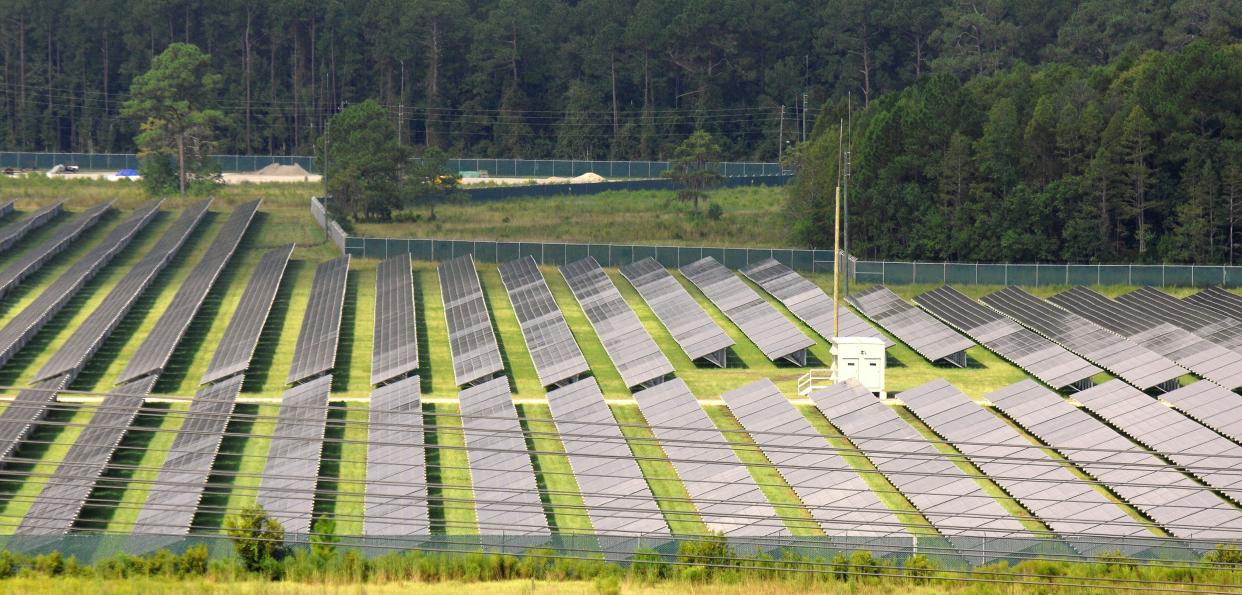JEA eyes solar farms and new natural gas plant in coming years

As utilities roll out plans for how they will cut back on greenhouse gas emissions that contribute to climate change, JEA has been meeting with representatives of businesses, nonprofits, local governments, and environmental groups to forge a plan for how it will produce electricity in the decades to come.
It's a mix of perspectives that's guaranteed to generate live-wire debate.
"We have never had a dull meeting," Laura Marshall Schepis, chief external affairs officer, told the JEA board's Finance Committee during a recent update on the plan.
Two local environmental groups, the Sierra Club of Northeast Florida and the St. Johns Riverkeeper, have used JEA's invitation to join those discussions as a way to urge more renewable energy while pressing JEA to put a hard stop on ever building another power plant using fossil fuels whose greenhouse gas emissions trap heat in the atmosphere.
"We're really talking about are we going to leave a planet that's livable for future generations," said Logan Cross, chairman of the Sierra Club of Northeast Florida.
Jacksonville utilityJEA's solar outlook darkens as solar farms fail to get built after $34 million land buy
Residential rates:JEA plans electric 'base rate' increase but still sees overall bills going down
The environmental groups appear to be on their way to getting half of what they want.
JEA's ongoing study, called an integrated resource plan, envisions launching a sizable expansion of solar farms that would make renewable energy a far bigger portion of how it generates electricity. But JEA also is putting construction of a new power plant fueled by natural gas in the mix of options that it's studying
"Our goal is to look at this from an environmental standpoint, from an affordable rate standpoint and from a reliability standpoint," JEA CEO Jay Stowe said. "If we can get affordable rates with high reliability and positive impact on the environment, that's the direction we will go."

He said he considers JEA to be "the most important environmental organization" in Northeast Florida in how it makes decisions that balance competing interests for supplying electric and water service to several hundred thousand customers.
Cross said he is not convinced JEA is "going to take bold steps" that will move it toward the Sierra Club's goal of JEA using renewable energy for all its electricity needs by 2050.
"I'm very appreciative they are hearing what we are advocating for, but I'm still skeptical they're going to take these recommendations and really put them into action," he said.
The advisory group will continue meeting into spring 2023 as JEA keeps working on the Integrated Resource Plan for release in May. It will serve as a roadmap for JEA in the coming decades as it makes decisions on large-scale investments that, for better or worse, will have lasting impacts on the environment and the cost of electricity that turns on everything from the living room lamp to assembly lines.
JEA plans growth of solar farms
The biggest change being studied by JEA would be a large-scale expansion of solar power. JEA now gets just 1% to 2% of its electricity from renewable energy, mainly produced by eight small solar farms that provide a total of 39 megawatts of production.
In January the board will vote on a proposed deal for using a 150-megawatt solar source in the Florida Power & Light system. That contract would start in April and be a "solar bridge" to more renewable energy for JEA, according to a staff presentation.
The Integrated Resource Plan shows scenarios for construction of new solar farms in Jacksonville totaling around 300 megawatts of capacity in 2026. That could be followed by another round of additional solar capacity for 750 to 975 megawatts by around 2030.
Like agricultural farms, solar arrays need large tracts of land to make a large impact, but JEA already has big parcels in its possession from a past failed attempt at ramping up solar.
Plant Vogtle:JEA loses Plant Vogtle nuclear power lawsuit
JEA paid $34 million in 2017 and 2018 for the purchase of nearly 3,400 acres at five sites for its "Jacksonville 5" plan that would have leased the land to a private company, EDF Renewables, for it to build five solar farms totaling 250 megawatts of solar energy capacity.
The purchase of the land came as JEA pledged to ramp up solar energy, a move that won praise from environmentalists at the time. The JEA board also approved a mandate in 2017 that 30% of its fuel come from zero-carbon or carbon-neutral projects by 2030.
EDF never broke ground on the solar farms, however, and JEA agreed to part ways with the company earlier this year. Stowe said four of the five sites appear suitable for another shot at solar farms.
The long-delayed expansion of the Plant Vogtle nuclear plant in Georgia also will give JEA a source of carbon-free electricity when it's finally able to purchase nuclear power, though it will be a much steeper cost than what JEA expected when it entered into that power purchase contract in 2008.
The move to expand renewable energy in JEA's future plans isn't ending JEA's use of fossil fuels, however. Natural gas, coal and petroleum coke, which is a byproduct of the oil refining process, still would be major carbon-based fuels for creating the energy that generates electricity.
Plants that use nuclear energy and fossil fuels don't depend on sunshine for their energy so they can operate for longer stretches and produce more electricity over a 24-hour period.
"The solar comes on and off based on cloud cover and sun, and nighttime or daytime," Stowe said.
The scenarios in the Integrated Resource Plan show JEA shutting down one of the three units at the Northside Generating Station in 2029 while also building a new natural gas plant in the range of 350 megawatts to 570 megawatts.
JEA would decommission the Northside unit that burns natural gas, leaving the two other units in operation that use coal and pet coke. The Sierra Club wants JEA to close the two coal-burning units and stop building any new plants using natural gas.
"With Northside Generating Stations, we're not saying decommission that tomorrow," Cross said. "We're saying set the target at 2030 and then try to meet that target."
He said if JEA builds a new natural gas plant, it risks seeing that technology "become a relic" as advances in renewable energy, such as battery storage for solar power, make it more cost-effective. He said incentives for JEA customers to install rooftop solar also should be part of JEA's plan.
Cross said the Sierra Club wants Jacksonville to join 13 other Florida cities — a group that includes Orlando, St. Petersburg, Tallahassee and Gainesville — that have enacted resolutions to achieve 100% clean, renewable energy by 2050 or sooner He said making that request in Jacksonville cannot happen until JEA puts out a plan that shows a path to make that goal achievable.
"Really, Jacksonville and JEA are behind the curve big time and we're just asking them to get on board," he said. "If other cities and utilities are committing to this, collectively it can have an impact, and JEA does need to get on board with other utilities in making this transition to renewable energy."
This article originally appeared on Florida Times-Union: Sierra Club pushes JEA for more renewable energy

